Quadratic Equations
- 格式:docx
- 大小:24.48 KB
- 文档页数:3
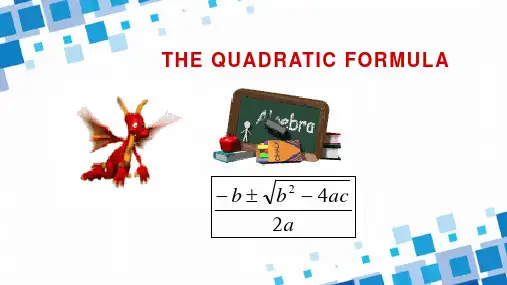
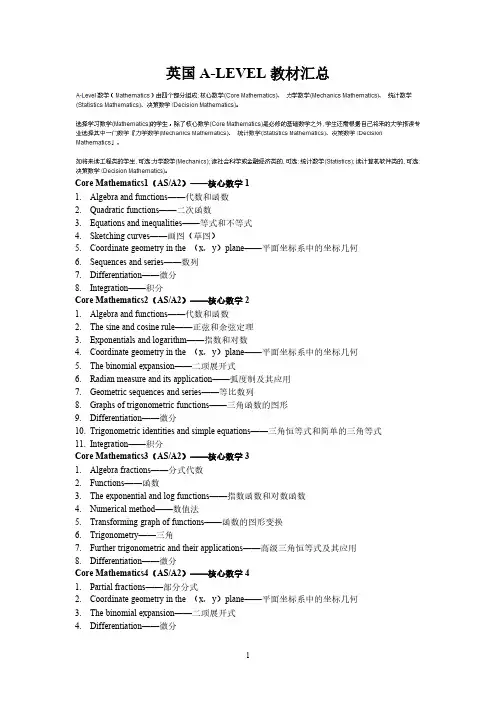
英国A-LEVEL教材汇总Core Mathematics1(AS/A2)——核心数学11.Algebra and functions——代数和函数2.Quadratic functions——二次函数3.Equations and inequalities——等式和不等式4.Sketching curves——画图(草图)5.Coordinate geometry in the (x,y)plane——平面坐标系中的坐标几何6.Sequences and series——数列7.Differentiation——微分8.Integration——积分Core Mathematics2(AS/A2)——核心数学21.Algebra and functions——代数和函数2.The sine and cosine rule——正弦和余弦定理3.Exponentials and logarithm——指数和对数4.Coordinate geometry in the (x,y)plane——平面坐标系中的坐标几何5.The binomial expansion——二项展开式6.Radian measure and its application——弧度制及其应用7.Geometric sequences and series——等比数列8.Graphs of trigonometric functions——三角函数的图形9.Differentiation——微分10.Trigonometric identities and simple equations——三角恒等式和简单的三角等式11.Integration——积分Core Mathematics3(AS/A2)——核心数学31.Algebra fractions——分式代数2.Functions——函数3.The exponential and log functions——指数函数和对数函数4.Numerical method——数值法5.Transforming graph of functions——函数的图形变换6.Trigonometry——三角7.Further trigonometric and their applications——高级三角恒等式及其应用8.Differentiation——微分Core Mathematics4(AS/A2)——核心数学41.Partial fractions——部分分式2.Coordinate geometry in the (x,y)plane——平面坐标系中的坐标几何3.The binomial expansion——二项展开式4.Differentiation——微分5.Vectors——向量6.Integration——积分A-Level:核心数学Core Maths,力学数学,统计数学,决策数学Core Mathematics1(AS/A2)——核心数学11.Algebra and functions——代数和函数2.Quadratic functions——二次函数3.Equations and inequalities——等式和不等式4.Sketching curves——画图(草图)5.Coordinate geometry in the (x,y)plane——平面坐标系中的坐标几何6.Sequences and series——数列7.Differentiation——微分8.Integration——积分每章内容:Core Mathematics2(AS/A2)——核心数学21.Algebra and functions——代数和函数2.The sine and cosine rule——正弦和余弦定理3.Exponentials and logarithm——指数和对数4.Coordinate geometry in the (x,y)plane——平面坐标系中的坐标几何5.The binomial expansion——二项展开式6.Radian measure and its application——弧度制及其应用7.Geometric sequences and series——等比数列8.Graphs of trigonometric functions——三角函数的图形9.Differentiation——微分10.Trigonometric identities and simple equations——三角恒等式和简单的三角等式11.Integration——积分每章内容:1.Algebra fractions——分式代数2.Functions——函数3.The exponential and log functions——指数函数和对数函数4.Numerical method——数值法5.Transforming graph of functions——函数的图形变换6.Trigonometry——三角7.Further trigonometric and their applications——高级三角恒等式及其应用8.Differentiation——微分每章内容:1.Partial fractions——部分分式2.Coordinate geometry in the (x,y)plane——平面坐标系中的坐标几何3.The binomial expansion——二项展开式4.Differentiation——微分5.Vectors——向量6.Integration——积分每章内容:。
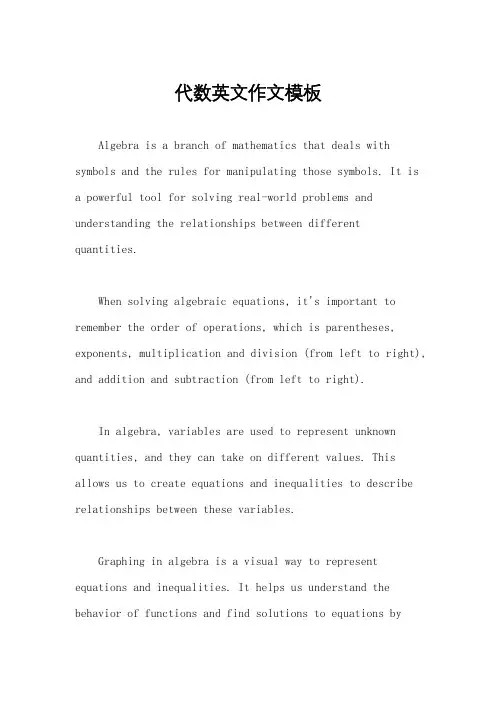
代数英文作文模板Algebra is a branch of mathematics that deals with symbols and the rules for manipulating those symbols. It is a powerful tool for solving real-world problems and understanding the relationships between different quantities.When solving algebraic equations, it's important to remember the order of operations, which is parentheses, exponents, multiplication and division (from left to right), and addition and subtraction (from left to right).In algebra, variables are used to represent unknown quantities, and they can take on different values. This allows us to create equations and inequalities to describe relationships between these variables.Graphing in algebra is a visual way to represent equations and inequalities. It helps us understand the behavior of functions and find solutions to equations byidentifying the points of intersection.Factoring is an important skill in algebra that involves breaking down algebraic expressions into simpler terms. It is useful for solving equations, simplifying expressions, and understanding the behavior of functions.Inequalities in algebra describe relationships that are not equal, and they are often represented on a number line. Solving inequalities involves finding the set of valuesthat make the inequality true.Quadratic equations are a type of algebraic equation that involves the square of a variable. They can be solved using different methods, such as factoring, completing the square, or using the quadratic formula.Algebraic expressions are combinations of numbers, variables, and operations, and they can be simplified by combining like terms and applying the rules of arithmetic.In conclusion, algebra is a fundamental part ofmathematics that provides a framework for solving problems, understanding relationships, and making sense of the world around us. It is a versatile tool that can be applied in various fields, from science and engineering to economics and social sciences.。
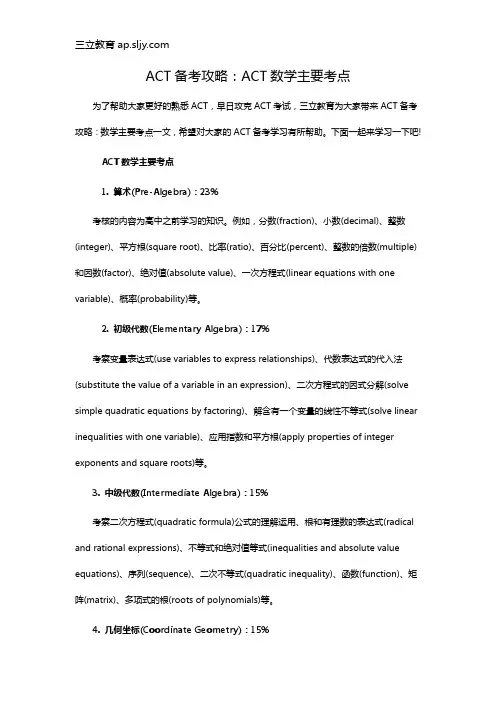
ACT备考攻略:ACT数学主要考点为了帮助大家更好的熟悉ACT,早日攻克ACT考试,三立教育为大家带来ACT备考攻略:数学主要考点一文,希望对大家的ACT备考学习有所帮助。
下面一起来学习一下吧!ACT数学主要考点1. 算术(Pre-Algebra):23%考核的内容为高中之前学习的知识。
例如,分数(fraction)、小数(decimal)、整数(integer)、平方根(square root)、比率(ratio)、百分比(percent)、整数的倍数(multiple)和因数(factor)、绝对值(absolute value)、一次方程式(linear equations with one variable)、概率(probability)等。
2. 初级代数(Elementary Algebra):17%考察变量表达式(use variables to express relationships)、代数表达式的代入法(substitute the value of a variable in an expression)、二次方程式的因式分解(solve simple quadratic equations by factoring)、解含有一个变量的线性不等式(solve linear inequalities with one variable)、应用指数和平方根(apply properties of integer exponents and square roots)等。
3. 中级代数(Intermediate Algebra):15%考察二次方程式(quadratic formula)公式的理解运用、根和有理数的表达式(radical and rational expressions)、不等式和绝对值等式(inequalities and absolute value equations)、序列(sequence)、二次不等式(quadratic inequality)、函数(function)、矩阵(matrix)、多项式的根(roots of polynomials)等。
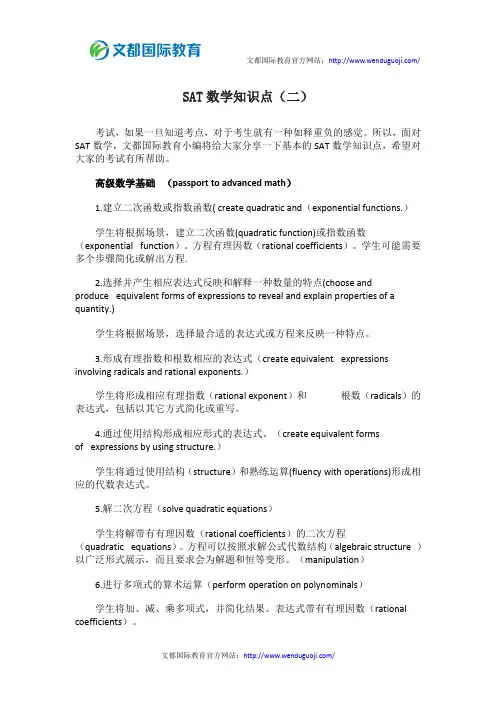
SAT数学知识点(二)考试,如果一旦知道考点,对于考生就有一种如释重负的感觉。
所以,面对SAT数学,文都国际教育小编将给大家分享一下基本的SAT数学知识点,希望对大家的考试有所帮助。
高级数学基础(passport to advanced math)1.建立二次函数或指数函数( create quadratic and(exponential functions.)学生将根据场景,建立二次函数(quadratic function)或指数函数(exponential function)。
方程有理因数(rational coefficients)。
学生可能需要多个步骤简化或解出方程.2.选择并产生相应表达式反映和解释一种数量的特点(choose andproduce equivalent forms of expressions to reveal and explain properties of a quantity.)学生将根据场景,选择最合适的表达式或方程来反映一种特点。
3.形成有理指数和根数相应的表达式(create equivalent expressions involving radicals and rational exponents.)学生将形成相应有理指数(rational exponent)和根数(radicals)的表达式,包括以其它方式简化或重写。
4.通过使用结构形成相应形式的表达式。
(create equivalent formsof expressions by using structure.)学生将通过使用结构(structure)和熟练运算(fluency with operations)形成相应的代数表达式。
5.解二次方程(solve quadratic equations)学生将解带有有理因数(rational coefficients)的二次方程(quadratic equations)。
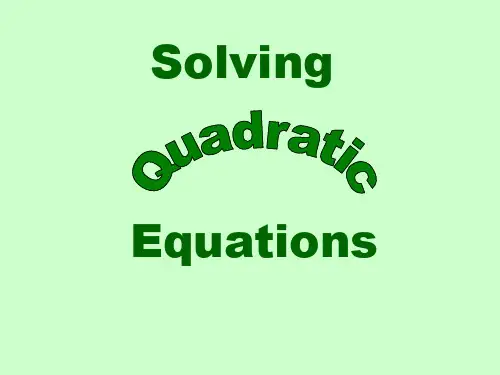
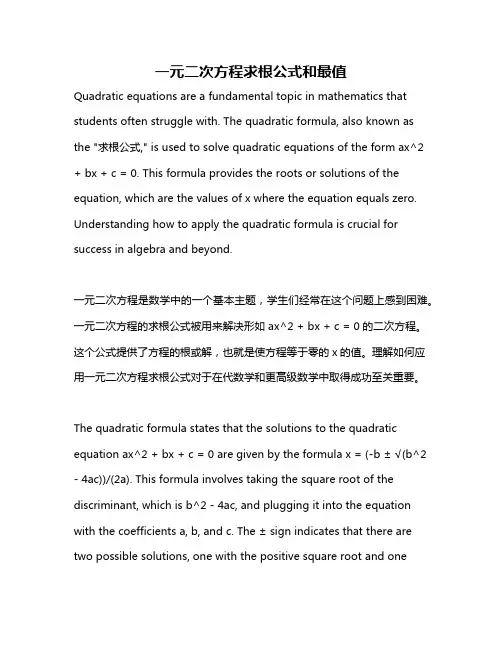
一元二次方程求根公式和最值Quadratic equations are a fundamental topic in mathematics that students often struggle with. The quadratic formula, also known as the "求根公式," is used to solve quadratic equations of the form ax^2 + bx + c = 0. This formula provides the roots or solutions of the equation, which are the values of x where the equation equals zero. Understanding how to apply the quadratic formula is crucial for success in algebra and beyond.一元二次方程是数学中的一个基本主题,学生们经常在这个问题上感到困难。
一元二次方程的求根公式被用来解决形如ax^2 + bx + c = 0的二次方程。
这个公式提供了方程的根或解,也就是使方程等于零的x的值。
理解如何应用一元二次方程求根公式对于在代数学和更高级数学中取得成功至关重要。
The quadratic formula states that the solutions to the quadratic equation ax^2 + bx + c = 0 are given by the formula x = (-b ± √(b^2 - 4ac))/(2a). This formula involves taking the square root of the discriminant, which is b^2 - 4ac, and plugging it into the equation with the coefficients a, b, and c. The ± sign indicates that there are two possible solutions, one with the positive square root and onewith the negative square root. This allows for the calculation of the two roots of the quadratic equation.一元二次方程求根公式表明,一元二次方程ax^2 + bx + c = 0的解由公式x = (-b ± √(b^2 - 4ac))/(2a)给出。
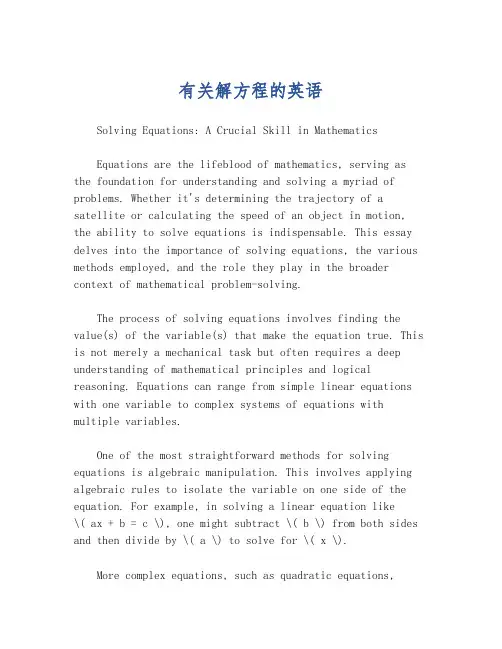
有关解方程的英语Solving Equations: A Crucial Skill in MathematicsEquations are the lifeblood of mathematics, serving as the foundation for understanding and solving a myriad of problems. Whether it's determining the trajectory of a satellite or calculating the speed of an object in motion, the ability to solve equations is indispensable. This essay delves into the importance of solving equations, the various methods employed, and the role they play in the broader context of mathematical problem-solving.The process of solving equations involves finding the value(s) of the variable(s) that make the equation true. This is not merely a mechanical task but often requires a deep understanding of mathematical principles and logical reasoning. Equations can range from simple linear equations with one variable to complex systems of equations with multiple variables.One of the most straightforward methods for solving equations is algebraic manipulation. This involves applying algebraic rules to isolate the variable on one side of the equation. For example, in solving a linear equation like\( ax + b = c \), one might subtract \( b \) from both sides and then divide by \( a \) to solve for \( x \).More complex equations, such as quadratic equations,often require the use of specific formulas or methods. The quadratic formula \( x = \frac{-b \pm \sqrt{b^2 - 4ac}}{2a} \) is a staple in mathematics for finding the roots of any quadratic equation \( ax^2 + bx + c = 0 \).In addition to algebraic methods, graphical methods can also be used to solve equations. By plotting the equation ona graph, one can visually determine the points where thecurve intersects the x-axis, which correspond to thesolutions of the equation.The advent of technology has revolutionized the way we solve equations. Calculators and computer software canquickly and accurately solve even the most complex equations, making it easier for students and professionals alike to find solutions.Solving equations is not just a mathematical exercise; it has real-world applications in various fields. Engineers use equations to design structures, economists to model market behavior, and scientists to understand natural phenomena. The ability to solve equations is a gateway to deeper understanding and innovation across disciplines.In conclusion, solving equations is a fundamental skillin mathematics that is essential for both academic andpractical applications. It requires a combination ofalgebraic techniques, logical thinking, and sometimes the aid of technology. As mathematics continues to evolve, so toowill the methods for solving equations, ensuring that thiscrucial skill remains relevant and powerful in the quest for knowledge and solutions to complex problems.。

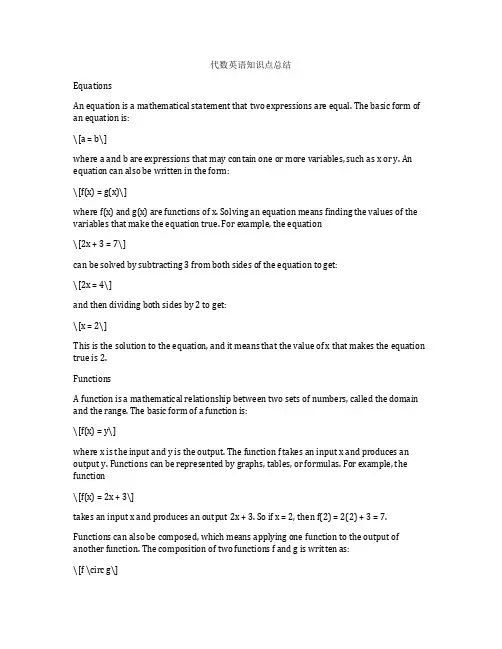
代数英语知识点总结EquationsAn equation is a mathematical statement that two expressions are equal. The basic form of an equation is:\[a = b\]where a and b are expressions that may contain one or more variables, such as x or y. An equation can also be written in the form:\[f(x) = g(x)\]where f(x) and g(x) are functions of x. Solving an equation means finding the values of the variables that make the equation true. For example, the equation\[2x + 3 = 7\]can be solved by subtracting 3 from both sides of the equation to get:\[2x = 4\]and then dividing both sides by 2 to get:\[x = 2\]This is the solution to the equation, and it means that the value of x that makes the equation true is 2.FunctionsA function is a mathematical relationship between two sets of numbers, called the domain and the range. The basic form of a function is:\[f(x) = y\]where x is the input and y is the output. The function f takes an input x and produces an output y. Functions can be represented by graphs, tables, or formulas. For example, the function\[f(x) = 2x + 3\]takes an input x and produces an output 2x + 3. So if x = 2, then f(2) = 2(2) + 3 = 7. Functions can also be composed, which means applying one function to the output of another function. The composition of two functions f and g is written as:\[f \circ g\]and is defined as:\[(f \circ g)(x) = f(g(x))\]InequalitiesAn inequality is a mathematical statement that one expression is greater than, less than, or not equal to another expression. The basic forms of inequalities are:\[a > b\]\[a < b\]\[a \geq b\]\[a \leq b\]\[a \neq b\]where a and b are expressions that may contain one or more variables. Solving an inequality means finding the values of the variables that make the inequality true. For example, the inequality\[3x + 5 > 8\]can be solved by subtracting 5 from both sides of the inequality to get:\[3x > 3\]and then dividing both sides by 3 to get:\[x > 1\]This is the solution to the inequality, and it means that the value of x that makes the inequality true is greater than 1.Systems of EquationsA system of equations is a collection of two or more equations that are considered together. The basic form of a system of equations is:\[ \begin{cases} f(x) = g(x) \\ h(x) = k(x) \end{cases} \]where f(x), g(x), h(x), and k(x) are functions of x. Solving a system of equations means finding the values of the variables that make all of the equations true simultaneously. For example, the system of equations\[ \begin{cases} 2x + y = 5 \\ x - y = 1 \end{cases} \]can be solved by adding the two equations to eliminate y and then solving for x, and then substituting the value of x back into one of the equations to find the value of y. The solution to this system of equations is x = 2 and y = 1.PolynomialsA polynomial is a mathematical expression that can be written as a sum of terms, where each term is the product of a constant coefficient and one or more variables raised to non-negative integer exponents. The basic form of a polynomial is:\[a_nx^n + a_{n-1}x^{n-1} + ... + a_1x + a_0\]where a_n, a_{n-1}, ..., a_1, a_0, and x are constants and variables. The highest power of the variable x in the polynomial is called its degree. For example, the polynomial\[2x^3 - 3x^2 + 5x - 7\]is a degree 3 polynomial.FactoringFactoring is the process of writing a polynomial as a product of two or more simpler polynomials. The basic form of factoring is:\[f(x) = g(x) \cdot h(x)\]where f(x) is the original polynomial and g(x) and h(x) are the factored polynomials. For example, the polynomial\[x^2 - 4\]can be factored as:\[x^2 - 4 = (x + 2)(x - 2)\]This is called the difference of squares factorization.Quadratic EquationsA quadratic equation is a second-degree polynomial equation of the form:\[ax^2 + bx + c = 0\]where a, b, and c are constants and a is not equal to 0. The solutions to a quadratic equation can be found using the quadratic formula:\[x = \frac{-b \pm \sqrt{b^2 - 4ac}}{2a}\]where the \(\pm\) symbol means that there are two possible solutions, one with the plus sign and one with the minus sign.Matrices and DeterminantsA matrix is a rectangular array of numbers, and a determinant is a value associated with a square matrix. Matrices and determinants are used in many areas of mathematics and science, such as solving systems of linear equations, solving differential equations, and solving problems in physics and engineering.Complex NumbersA complex number is a number that can be written in the form:\[a + bi\]where a and b are real numbers and i is the imaginary unit, which is defined as the square root of -1. Complex numbers are used in many areas of mathematics, such as solving polynomial equations, solving differential equations, and representing periodic phenomena in physics and engineering.In conclusion, algebra is a powerful and versatile tool that is used in many different areas of mathematics and science. Its concepts and techniques are fundamental to understanding and solving a wide variety of mathematical and real-world problems. By mastering the key concepts and techniques in algebra, students can develop a strong foundation for further study in various fields and improve their problem-solving skills.。
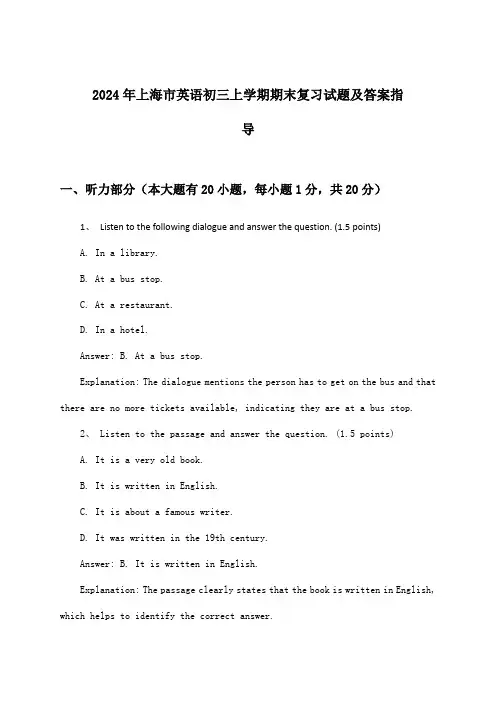
2024年上海市英语初三上学期期末复习试题及答案指导一、听力部分(本大题有20小题,每小题1分,共20分)1、Listen to the following dialogue and answer the question. (1.5 points)A. In a library.B. At a bus stop.C. At a restaurant.D. In a hotel.Answer: B. At a bus stop.Explanation: The dialogue mentions the person has to get on the bus and that there are no more tickets available, indicating they are at a bus stop.2、 Listen to the passage and answer the question. (1.5 points)A. It is a very old book.B. It is written in English.C. It is about a famous writer.D. It was written in the 19th century.Answer: B. It is written in English.Explanation: The passage clearly states that the book is written in English, which helps to identify the correct answer.3、Question: What are the twins doing right now?A. They are reading books in the library.B. They are watching a movie at home.C. They are playing soccer in the park.Answer: CExplanation: The twins are often seen playing sports, and the context implies they are engaged in an outdoor activity. Therefore, the correct answer is that they are playing soccer in the park.4、Question: How do the students feel about their teacher after the school trip?A. They are sad because the teacher is too strict.B. They are happy because the teacher is very friendly.C. They are confused because the teacher is not clear about the trip rules.Answer: BExplanation: The conversation before the question mentions how the teacher made the trip fun for everyone and involved the students actively. This suggests a positive experience, making the best answer that the students are happy because the teacher is very friendly.5.You hear a conversation between two students, John and Sarah, discussing their summer plans.John: “Hey Sarah, have you decided what you’re going to do for your summer vacation?”Sarah: “Well, I’m planning to go on a trip to the beach. How about you?”Question: What is Sarah’s summer plan?A) Go on a beach tripB) Visit her grandparentsC) Study abroadD) Work part-timeAnswer: A) Go on a beach tripExplanation: Sarah directly states her plan to go on a trip to the beach, which makes option A the correct answer.6.You hear a news report about a local charity event that took place last weekend.Reporter: “Last weekend, the local community center hosted a charity event to raise funds for the children’s hospital. Many local businesses and individuals donated money and time. The event included a bake sale, a silent auction, and a talent show. According to the organizers, the event was a great success and they were able to raise over$5,000 for the hospital.”Question: What did the charity event raise money for?A) A local schoolB) The children’s hospitalC) A local shelterD) An animal sanctuaryAnswer: B) The children’s hospit alExplanation: The news report explicitly mentions that the charity event was for the children’s hospital, making option B the correct answer.7、 According to the weather forecast, the temperature will significantly drop tomorrow.•Answer: C•Explanation: The correct answer is C, as the forecast mentions the temperature will significantly drop. The other options do not accurately reflect what the forecast states.8、The speaker suggests that students should start studying from now on to prepare for the exam.•Answer: B•Explanation: The correct answer is B because the speaker advises students to begin their studies promptly to ensure good preparation for theupcoming exam. The other options do not align with the advice given in the recording.9.You are listening to a conversation between two students, Anna and Bob, discussing their vacation plans.Anna: Hi Bob, I’m thinking of going to Greece for my vacation. Have you considered anywhere else?Bob: (Answer)A) I thought about Portugal but isn’t it a bit too hot in the summer?B) Yeah, Greece sounds great. Maybe the Amalfi Coast could be an interesting alternative.C) Personally, I’m looking into visiting Japan, but I’m unsure if it’s too far.Answer: B) Yeah, Greece sounds great. Maybe the Amalfi Coast could be an interesting alternative.解析: Bob回复说“Greece sounds great. Maybe the Amalfi Coast could be an interesting alternative.”,这表明他认为希腊听起来很好,可能还会考虑意大利的阿马尔菲海岸作为另一个选择。
中英文数学知识点总结1. Basic ArithmeticArithmetic is the branch of mathematics that deals with the basic operations such as addition, subtraction, multiplication, and division. These operations are used in everyday life for tasks such as budgeting, shopping, and cooking. Understanding basic arithmetic is essential for building a strong foundation in mathematics.1.1 Addition and SubtractionAddition is the process of combining two or more numbers to find their sum, while subtraction involves finding the difference between two numbers. For example, 5 + 3 = 8 and 10 - 2 = 8.1.2 Multiplication and DivisionMultiplication is the process of repeated addition, while division is the process of sharing a quantity into equal parts. For example, 3 x 4 = 12 and 12 ÷ 3 = 4.1.3 Order of OperationsThe order of operations is a set of rules that determines the sequence in which mathematical operations should be performed. The acronym PEMDAS (Parentheses, Exponents, Multiplication and Division, Addition and Subtraction) is used to remember the correct order of operations.2. AlgebraAlgebra is a branch of mathematics that uses symbols and letters to represent numbers and quantities. It is used to solve equations and analyze patterns and relationships.2.1 Solving EquationsEquations are mathematical statements that express the equality of two expressions. Solving equations involves finding the value of the variable that makes the equation true. For example, in the equation 2x + 3 = 7, the value of x is 2.2.2 Linear EquationsLinear equations are equations of the form y = mx + b, where m is the slope and b is the y-intercept. They represent straight lines on a graph and are used to analyze relationships between two variables.2.3 Quadratic EquationsQuadratic equations are equations of the form ax^2 + bx + c = 0, where a, b, and c are constants and x is the variable. They can be solved using the quadratic formula or by factoring.3. GeometryGeometry is the branch of mathematics that deals with shapes, sizes, and properties of space. It is used to measure and analyze the physical world, and is also important in fields such as architecture and engineering.3.1 Basic ShapesBasic shapes such as circles, rectangles, triangles, and squares are studied in geometry. Their properties, area, and perimeter are important concepts in geometry.3.2 Angles and LinesAngles are formed by two rays with a common endpoint, and are measured in degrees. Lines can be intersecting, parallel, or perpendicular, and are used to create shapes and patterns.3.3 PolygonsPolygons are closed shapes with straight sides. They can be classified by the number of sides, such as triangles (3 sides), quadrilaterals (4 sides), pentagons (5 sides), and so on. 4. TrigonometryTrigonometry is the branch of mathematics that deals with the relationships between the angles and sides of triangles. It is used in fields such as astronomy, engineering, and physics.4.1 Trigonometric FunctionsSine, cosine, and tangent are the basic trigonometric functions that relate the angles of a right-angled triangle to the lengths of its sides.4.2 Trigonometric IdentitiesTrigonometric identities are equalities involving trigonometric functions that are true for all values of the variables. They are used to simplify and solve trigonometric equations.4.3 Applications of TrigonometryTrigonometry is used to calculate distances and angles in navigation, to analyze periodic phenomena such as sound and light waves, and to solve problems in engineering and science.5. CalculusCalculus is a branch of mathematics that deals with the study of change and motion. It is used in fields such as physics, engineering, economics, and computer science.5.1 DifferentiationDifferentiation is the process of finding the rate at which a function is changing. It is used to calculate slopes, velocities, and rates of change.5.2 IntegrationIntegration is the process of finding the accumulated change in a function. It is used to calculate areas, volumes, and accumulated quantities.5.3 Applications of CalculusCalculus is used to analyze and model physical phenomena such as motion, growth, and decay. It is also used in optimization problems in economics and engineering.6. Probability and StatisticsProbability and statistics are branches of mathematics that deal with the study of uncertainty and data analysis. They are used in fields such as finance, marketing, and medicine.6.1 ProbabilityProbability is the study of the likelihood of events occurring. It is used to analyze random phenomena and make predictions based on data.6.2 Descriptive StatisticsDescriptive statistics are used to summarize and describe the features of a dataset. Measures such as mean, median, mode, and standard deviation are important in data analysis.6.3 Inferential StatisticsInferential statistics are used to make predictions and inferences about a population based on a sample of data. Techniques such as hypothesis testing and regression analysis are used in inferential statistics.7. Real NumbersReal numbers include all the rational and irrational numbers, and are used to represent quantities and measurements in mathematics.7.1 Rational NumbersRational numbers are numbers that can be expressed as a ratio of two integers, such as 3/4 or -5/7. They can be represented as fractions or decimals.7.2 Irrational NumbersIrrational numbers are numbers that cannot be expressed as a ratio of two integers, and have non-repeating and non-terminating decimal representations. Examples include π and √2.8. Linear AlgebraLinear algebra is the branch of mathematics that deals with the study of vectors, matrices, and systems of linear equations. It is used in fields such as computer graphics, cryptography, and quantum mechanics.8.1 VectorsVectors are quantities that have magnitude and direction, and are used to represent physical quantities such as force and velocity. They can be added, subtracted, and multiplied by scalars.8.2 MatricesMatrices are arrays of numbers that are used to represent and solve systems of linear equations. They are also used to perform operations such as addition, subtraction, multiplication, and inversion.8.3 Eigenvalues and EigenvectorsEigenvalues and eigenvectors are important concepts in linear algebra that are used to analyze and solve systems of linear equations. They are also used in applications such as principal component analysis and quantum mechanics.In conclusion, mathematics is a diverse and essential field of study that is used in various fields and everyday life. From basic arithmetic to advanced topics such as calculus and linear algebra, mathematics plays a crucial role in our lives. Understanding and mastering mathematical concepts and topics is important for developing problem-solving skills and analytical thinking. Whether you are a student, a professional, or simply a curious learner, having a solid understanding of mathematical knowledge is beneficial and empowering.。
方程的英语知识点总结Key Concepts of Equations:1. Definition of an Equation: An equation is a mathematical statement that asserts the equality of two expressions, typically denoted as LHS = RHS, where LHS (left-hand side) and RHS (right-hand side) are mathematical expressions containing variables and constants.2. Variables and Constants: In an equation, variables are symbols that represent unknown quantities, while constants are fixed numerical values. Equations allow us to solve for the value of the variable by manipulating the given information and applying various mathematical operations.3. Solutions of an Equation: The solution of an equation is the value or set of values for the variable that make the equation true. A solution to an equation satisfies the equality relationship between the LHS and RHS.4. Solving Equations: The process of finding the solutions to an equation involves using algebraic techniques to manipulate the given expressions and isolate the variable. Common methods for solving equations include combining like terms, applying inverse operations, and factoring.5. Equivalent Equations: Two equations are said to be equivalent if they have the same solution set. Algebraic manipulations such as adding or subtracting the same quantity from both sides, multiplying or dividing both sides by the same non-zero number, and applying the properties of exponents can be used to derive equivalent equations.6. Applications of Equations: Equations are used to model various real-world scenarios, such as calculating the trajectory of a projectile, determining the growth of populations, analyzing the behavior of electrical circuits, and predicting the spread of infectious diseases. Types of Equations:1. Linear Equations: A linear equation is an equation of the form ax + b = c, where x is the variable, a and b are constants, and c is a constant term. The graph of a linear equation is a straight line, and the solutions to a linear equation form a single point, a line, or no points (in the case of parallel lines).2. Quadratic Equations: A quadratic equation is an equation of the form ax^2 + bx + c = 0, where x is the variable, and a, b, and c are constants with a ≠ 0. Quadratic equations have solutions that can be found using the quadratic formula, factoring, or completing the square. The graph of a quadratic equation is a parabola.3. Exponential Equations: An exponential equation is an equation in which the unknown variable appears as an exponent. Exponential equations arise in situations involving exponential growth or decay, such as population growth, radioactive decay, and compound interest problems.4. Trigonometric Equations: Trigonometric equations involve trigonometric functions such as sine, cosine, and tangent. These equations often arise in problems related to periodic phenomena, wave functions, and harmonic motion.Properties of Equations:1. Reflexive Property: For any real number a, a = a.2. Symmetric Property: If a = b, then b = a.3. Transitive Property: If a = b and b = c, then a = c.4. Addition Property of Equality: If a = b, then a + c = b + c.5. Subtraction Property of Equality: If a = b, then a - c = b - c.6. Multiplication Property of Equality: If a = b, then ac = bc.7. Division Property of Equality: If a = b and c ≠ 0, then a/c = b/c.8. Multiplicative Property of Zero: For any real number a, a × 0 = 0.9. Multiplicative Property of One: For any real number a, a × 1 = a.10. Distributive Property: For any real numbers a, b, and c, a(b + c) = ab + ac.In conclusion, equations are a vital aspect of mathematics and are used to express and solve a wide range of problems in various fields. Understanding the key concepts, types, and properties of equations is essential for mastering algebra and applying mathematical principles to real-world situations. By studying equations and their properties, one can develop problem-solving skills and analytical thinking, which are invaluable in academic, professional, and everyday life.。
1. 中级代数(Intermediate Algebra):考察二次方程式(quadratic formula)公式的理解运用、根和有理数的表达式(radical and rational expressions)、不等式和绝对值等式(inequalities and absolute value equations)、序列(sequence)、二次不等式(quadratic inequality)、函数(function)、矩阵(matrix)、多项式的根(roots of polynomials)等。
2. 算术(Pre-Algebra):考核的内容为高中之前学习的知识。
例如,分数(fraction)、小数(decimal)、整数(integer)、平方根(square root)、比率(ratio)、百分比(percent)、整数的倍数(multiple)和因数(factor)、绝对值(absolute value)、一次方程式(linear equations with one variable)、概率(probability)等。
3. 平面几何(Plane Geometry):考生需掌握平面图形的性质和关系,包括角(triangle)、矩形(rectangle)、平行四边形(parallelogram)、梯形(trapezoid)、圆(circle)、平行线(parallel line)、正交线(perpendicular line)、平移(translation)、旋转(rotation)、周长(perimeter)、面积(area)、体积(volume)等。
4. 几何坐标(Coordinate Geometry):考察标准x,y坐标平面(standard (x ,y) coordinate plane)中的点(point)、线(line)、多项式(polynomial)、圆(circle)、曲线(curve)、斜率(slope)、平行(parallel)、垂直(perpendicular)、距离(distance)、中点(midpoint)、变换(transformation)、二次曲线(conic)等。
英语面试数学专业知识1. IntroductionThis document aims to provide an overview of the essential mathematical knowledge that may be relevant for an English interview in the field of mathematics. The topics covered in this document include algebra, calculus, probability, and statistics. It is important to note that the information provided here is for reference purposes only and should not be considered an exhaustive list of topics.2. AlgebraAlgebra plays a fundamental role in mathematics and is a crucial subject in the study of numbers, equations, and structures. Some key topics in algebra that may be relevant for an English interview include:•Linear equations and inequalities: Understanding how to solve linear equations and inequalities is essential. This includes the concept of slope, graphing linear equations, and solving systems of linear equations.•Quadratic equations: Knowledge of quadratic equations, including factoring, completing the square, and the quadratic formula, is important. It is also valuable to understand the graphical representation of quadratic functions.•Exponents and logarithms: Familiarity with exponents and logarithms is crucial. This includes knowledge of the laws of exponents,simplifying expressions with exponents, and solving equations involvinglogarithms.3. CalculusCalculus is a branch of mathematics that deals with rates of change and accumulation. Some key topics in calculus that may be relevant for an English interview include:•Differentiation: Understanding the concept of derivatives, including the rules of differentiation, finding derivatives of basic functions, and applying differentiation to solve problems.•Integration: Familiarity with integration is important. This includes knowledge of the fundamental theorem of calculus, techniques of integration, and applications of integration in finding areas and volumes.•Limits: Understanding the concept of limits is crucial for calculus.This includes evaluating limits, understanding the properties of limits, andapplying limits to define derivatives and integrals.4. Probability and StatisticsProbability and statistics are essential branches of mathematics that deal with uncertainty and data analysis. Some key topics in probability and statistics that may be relevant for an English interview include:•Probability theory: Understanding the basic principles of probability, including sample spaces, events, and probability functions. It is also valuable to know how to calculate probabilities using counting techniques, such aspermutations and combinations.•Descriptive statistics: Familiarity with descriptive statistics is important. This includes knowledge of measures of central tendency (mean,median, mode) and measures of variability (variance, standard deviation).•Hypothesis testing: Knowledge of hypothesis testing is valuable. This includes understanding the concepts of null and alternative hypotheses, Type I and Type II errors, and performing hypothesis tests for means and proportions.5. ConclusionIn conclusion, this document has provided an overview of the essential mathematical knowledge that may be relevant for an English interview in the fieldof mathematics. The topics covered include algebra, calculus, probability, and statistics. It is important to note that this is not an exhaustive list, and candidates should be prepared to demonstrate a strong understanding of mathematical concepts beyond what is presented here. Good luck with your interview!。
方程英语知识点总结1. What is an equation?An equation is a mathematical statement that shows the equality of two expressions. It typically contains one or more variables and is used to express a relationship between these variables. For example, the equation 2x + 3 = 7 shows that the expression 2x + 3 is equal to 7 when x has a value of 2.2. Types of equationsThere are several types of equations, each with its own unique characteristics and methods for solving. Some of the most common types of equations include:- Linear equations: These are equations of the form ax + b = c, where a, b, and c are constants, and x is the variable. Linear equations have a constant slope and form a straight line when graphed on a coordinate plane.- Quadratic equations: These are equations of the form ax^2 + bx + c = 0, where a, b, and c are constants, and x is the variable. Quadratic equations have a squared term and form a parabola when graphed.- Polynomial equations: These are equations that contain terms with multiple powers of the variable, such as x^3 + 2x^2 - 5x + 3 = 0.- Exponential equations: These are equations that involve exponential functions, such as2^x = 8.- Logarithmic equations: These are equations that involve logarithmic functions, such as log(x) = 2.- Trigonometric equations: These are equations that involve trigonometric functions, such as sin(x) = 0.5.- Rational equations: These are equations that contain rational expressions, such as 1/(x-2) + 1/(x+3) = 1.Each type of equation has its own specific methods for solving, and they can be used to model various real-world phenomena and solve practical problems.3. Solving equationsSolving an equation involves finding the values of the variable(s) that satisfy the given equation. There are several methods for solving different types of equations, including:- Algebraic methods: These include techniques such as factoring, completing the square, or using the quadratic formula for solving quadratic equations.- Graphical methods: These involve graphing the equation on a coordinate plane and determining the points of intersection with the x-axis to find the solutions.- Numerical methods: These involve using iterative algorithms or numerical techniques to approximate the solutions of equations that cannot be solved algebraically.- Trigonometric identities: These are used to simplify and solve trigonometric equations by using the properties of trigonometric functions.- Logarithmic and exponential properties: These are used to simplify and solve equations involving logarithmic and exponential functions by applying the properties of these functions.4. Applications of equationsEquations have numerous applications in various fields, and they are used to model and solve real-world problems in science, engineering, economics, and many other disciplines. Some common applications of equations include:- Physics: Equations such as Newton's second law of motion (F = ma) or the laws of thermodynamics are used to describe and predict the behavior of physical systems.- Engineering: Equations are used to design and analyze structures, machines, and electrical circuits, as well as to solve problems related to fluid mechanics, heat transfer, and materials science.- Economics: Equations are used to model economic relationships and solve optimization problems in areas such as supply and demand, production functions, and cost analysis.- Chemistry: Equations such as the ideal gas law (PV = nRT) or the rate laws for chemical reactions are used to describe the behavior of chemical substances and reactions.- Biology: Equations are used to model population growth, genetics, and ecological systems, as well as to analyze biological data and make predictions about biological processes.These are just a few examples of how equations are used in various fields, and they demonstrate the importance of equations in understanding and solving real-world problems.In conclusion, equations are a fundamental concept in mathematics, and they are used to represent relationships between variables and solve a wide range of problems in different fields. By understanding the different types of equations, methods for solving them, and applications in real-world problems, students can develop a strong foundation in mathematics and gain valuable skills for their future careers.。
Quadratic Equations
Let's glance at an example:
The setup cost for the project to develop
a new tank design is 50 thousand dollars.
The development cost is a function of time. In other words, the cost increases with time. From previous contracts, the cost function is estimated to be
t2- 10 t
where t is the time measured in working days. Suppose that a cost analyst has 650 thousand dollars allocated for the project, and he/she wants to know how long before he/she needs to allocate more resources to complete the project?
Let's consider a solution
The total cost for the tank is equal to the sum of the initial cost and the development cost.
t2- 10t + 50
If $650 thousand has been given, we want to know how much time before more resources need to be allocated?
t2- 10t + 50 = 650
If we move 650 to the left of the equal sign, this is what we have
t2- 10t - 600 = 0
To solve the equation above, we just factor the terms as follows:
(t + 20) (t - 30)
The equation yields two answers: t = -20 and t = 30. Since negative time has no physical meaning,
t = 30
is the only valid solution.
Thus, it takes 30working days before the cost analyst needs to allocate more resources to fund the project.
A few simple facts that you should know
Did you know that the above example has a quadratic equation?
A Quadratic Equation is a polynomial equation in which the highest power of the unknown variable is 2. The most
common form of a quadratic equation is an equation where the right hand side is set to zero and the highest exponent of any unknown variable is 2.。